Hotline: +381 61 63 84 071
Protecting Children from Abuse and Forced Labor in Serbia

Protecting Children from Abuse and Forced Labor in Serbia
Photo from NGO Atina arhive taken by Zorana Parezanovic
BELGRADE - Serbia needs to respond more clearly and firmly to the abuse of children and adopt a regulation on light forms of child labour that are not dangerous to the child's life and health, the NGO Atina announced today, on the occasion of June 12, the International Day Against Child Labor.
Citing that Serbian laws do not fully protect children from the worst forms of child labour, NGO Atina calls for the harmonisation of existing legal procedures, tightening penalties for perpetrators of crimes who force children to work, and strengthening the efficiency of inspection services, along with implementing adequate protective measures for children. In addition to adopting the Regulation on Light Forms of Child Labor, it is necessary to adopt the revised version of the Regulation on Severe Forms of Child Labor as soon as possible, enable better coordination between state services and civil society organisations in this area, raise awareness about the dangers of child labour, and provide specialised support to children and families from marginalised groups, with a particular emphasis on integrating these children into the education system and preventing their dropout.
While the public is debating whether children should be allowed to work in jobs such as newspaper sales, similar to the practice in the United States, following the release of a report by the International Labor Organization (ILO) last week stating that about 82,000 children aged five to 17 years are exposed to child labour in Serbia, accounting for about 10 per cent of the total child population, the seriousness of this issue and the plight of children who are victims of forced labour are being overlooked. These children, due to adult abuse, are deprived of the opportunity to grow and develop inhumane conditions.
Children in Serbia are also victims of being forced into the most severe forms of child labour, drug sales and distribution, begging, forced prostitution, and sexual exploitation. Since 2000, 1,383 victims of human trafficking have been identified, with the majority being children and young people. Due to their particular vulnerability, children are often exploited in multiple ways simultaneously, including starvation, deprivation of freedom of movement, denial of the right to choose, and the right to live free from violence. Some consequences of child exploitation through the worst forms of labour include inadequate socialisation, insecurity, emotional attachment issues, and distorted perceptions of the world and relationships among people.
Serbia has also committed to fulfilling the development goals set by the UN in 2000, notes Atina, adding that, according to findings by the US Department of Labor, minimal progress has been made to eliminate the worst forms of child labour in our country.
Over its 21 years of operation, NGO Atina has provided direct assistance and support to a total of 1,047 identified victims, half of whom were minors, including victims of forced marriage, labour exploitation, forced criminal activity, and sexual and labour exploitation.
The International Labor Organization reported that children are forced to work, among other reasons, because their survival and that of their families depend on their labour. Recent global estimates indicate that about 160 million children aged five to 14 are involved in child labour, with boys and girls in this age group being almost equally affected. Child labour is rooted in poverty, the lack of decent work for adults, inadequate social protection, and the failure to ensure that all children attend and complete school.
Children victims of forced labour in Serbia
Given that the Regulation on Light Work in Serbia has not been adopted, the issue of permissible work for children under 18 remains in a grey area without precise regulation, creating a risk that child labour abuse will not be punished. Without an agreed and adopted list, the positive side of work engagement, such as developing work habits, can quickly turn into child abuse. The absence of such regulation also poses a risk of children being abused in household chores, leading to negative consequences such as school absenteeism, complete withdrawal from the education system, and impaired physical health and psychosocial development in general.
According to the latest statistical data from the Center for the Protection of Human Trafficking Victims in Serbia for 2023, child victims made up 62.12% of all identified trafficking victims. Most were identified as victims of forced begging, forced criminal activity, sexual exploitation, and forced marriages (17.2%). Although there was an increase in the number of identified girls who were victims of forced marriages in 2023 compared to 2022, this number is far below the actual figure. Additionally, six children were identified as victims of multiple exploitation (four girls and two boys). Sexual exploitation of children mainly affects girls aged 13 to 18. It is concerning that the age limit is constantly decreasing, and in 2022 and 2023, there were cases of girls as young as 11 being exploited for pornographic purposes.
What needs to be done further
According to the Republic of Serbia laws, primary education is mandatory for all. However, according to the results of the 2022 census, 6.3% of the population did not attend school or completed less than eight grades of primary school, while 17.8% completed primary school, and 53.1% of the population aged 15 and over finished secondary school. It is estimated that 0.63% of the population aged ten and over is illiterate. Additionally, the enrollment of Roma children in primary education is still lower than the general average, and the dropout rate is significantly higher than other students. Data shows that the primary school completion rate for students from Roma settlements is only 64%.
In addition to inconsistent practices at the level of prosecutors' offices in different parts of the country, the protection and support system for children in the Republic of Serbia also suffers from a lack of specialised support programs for child victims of sexual violence, especially rape and sexual exploitation. It is necessary to strengthen the network of psychological support specialised foster families for highly traumatised children, child victims of sexual exploitation and sexual violence. The child protection system in the Republic of Serbia does not sufficiently meet the needs of children and is not narrowly specialised for child victims of various forms of exploitation; on the contrary, it is very broadly set, which is the key and most prominent problem of this system. Children suspected of being victims of sexual exploitation and pornography are usually identified only by the police and social work centres. Unfortunately, there are still professionals who justify the evident abuse of these children by attributing it to traditional and cultural customs.












 FACEBOOK
FACEBOOK TWITTER
TWITTER YOUTUBE
YOUTUBE